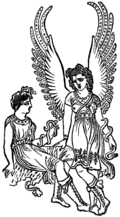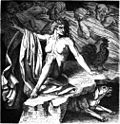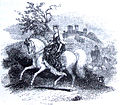List of 999 women of the Heritage Floor / Kali
This list describes the place settings for Kali on the table of Judy Chicago's art installation The Dinner Party . It is part of the list of 999 women on the Heritage Floor who are assigned to the respective place settings on the table. The names of the 999 women are on the tiles of the Heritage Floor, which is arranged below the table and belongs to the art installation.
description
The installation consists of a three-sided table, each with 13 historical or mythological personalities, thus a total of 39 people, from prehistory to the women's rights movement . These people were assigned a place setting at the table, consisting of an individually designed table runner, an individually designed plate, a goblet, knife, fork, spoon and serviette. The first page of the table is devoted to prehistory up to the Roman Empire , the second to Christianization up to the Reformation and the third from the American Revolution to the women's movement. Each place setting on the table is assigned additional personalities who have received an entry on the tiles of the Heritage Floor, which occupies the space under the table and the center of the space between the sides of the table. This list captures the personalities who are assigned to the Kali table setting. Your seat is on the first side of the table.
Hints
In addition to the names as they are used in German transcription or in scientific usage, the list shows the spelling chosen by Judy Chicago on the tiles.
The information on women who do not yet have an article in the German-language Wikipedia is referenced by the individual references listed under comments . If individual information in the table is not referenced via the main article, additional individual references are given at the relevant point. If there are any discrepancies between the information provided in Wikipedia articles and the descriptions of the work of art on the Brooklyn Museum website , this will also be indicated under Comments.
Place setting for potash
In Hinduism , Kali is the goddess of death and destruction, but also of renewal. Its meaning in Indian mythology is the embodiment of the wrath of Durga . Durga is the goddess of perfection, who can also take other forms. Kali has sprung from her forehead and is said to have filled the universe with her terrible roar. In the Hindu popular belief, Kali is one of the few goddesses who can grant wishes.
In the art installation "The Dinner Party" a place setting is dedicated to Kali and it is explained to her that the roots of her worship lie in the East Indian belief system. Mentions go back to the first millennium BC. Its origin is also described in the Devi Mahatmya . Kali is the most important manifestation of the Hindu mother goddess Durga . She is feared and revered at the same time, and the opposing forces of destruction and death as well as creation and redemption that she represents characterize her as both malevolent and nurturing. It stands for the inevitability of death, promotes acceptance and dispels fears. As a goddess, she stands for fertility, she is also the goddess of time and protector, who is used in disasters and epidemics. She represents the cycles of nature and could be interpreted as a creator who takes life to give new life. At the same time, she is a destroyer who kills what stands in the way of human purity and peace in life and death, such as evil, ignorance and selfishness.
Your table runner has wavy structures made of luminous and shimmering fabrics as a border, which have been covered with white shimmering fabrics to achieve a pearlescent effect. This is intended to allude to the skinned skin of a human corpse, as a direct evocation of Kali's power and her role in relation to death. The waves licking in the front part of the runner make a reference to the multi-armed manifestation of Kali. On the back of the barrel they open into a mouth-like opening, a "gaping gullet" as Chicago describes it. Due to the abstract representation, Kali's powers are represented as regenerative rather than as horrific. Kali's plate is painted in the center with kernels filled with seed shapes. They symbolize fertility and refer to Kali's connection to the cycles of nature. The plate is painted in deep red, purple and brown tones. From the picture in the center finger-like protrusions point to the edge of the plate, these are also sewn into the initial letter "K". The colors are intended to remind the viewer that the goddess drinks the blood of demons. The rib-like vertical bands on the plate are reminiscent of its anthropomorphic shape, which is typically depicted as emaciated with protruding ribs.
| Surname | Spelling on the tile | Date of birth | cultural spatial assignment | Remarks | image |
|---|---|---|---|---|---|
| Alukah | Alukah | N / A | Mesopotamia | Succubus or vampire , perhaps related to Lilith . Is mentioned in the Book of Proverbs . |

|
| Arianrhod | Arianrhod | N / A | Celtic mythology | A descendant of Don , the mother goddess. She is a main character in the epic poem "The Mabinogion ". | |
| Coatlicue | Coatlicue | N / A | Aztec mythology | Aztec goddess of life and death. Mythologically, the goddess represents a triadic union: She is seen as the mother, sister and consort of the sun god. |

|
| Ereškigal | Ereshkigal | N / A | Sumerian mythology | Supreme Sumerian snake goddess , who later changes her status as a primal deity in the creation of the world with the underworld Kurnugia . |

|
| Erinyes | The Furies | N / A | Greek mythology | Also known as Maniai by the Greeks , "the mad ones ", later as Eumenids, by the Romans as Furies - the Erinyes are three goddesses of revenge in Greek mythology. |

|
| Hecate | Hecate | N / A | Greek mythology | In Greek mythology, the goddess of magic , theurgy , necromancy . She is the goddess of crossroads, thresholds and crossings, the guardian of the gates between the worlds. |

|
| Hel | Hel | N / A | Norse mythology | Ruler of the underworld of the same name, also called Helheim . |

|
| Irkalla | Irkalla | N / A | Mesopotamian religion | Surname and place of residence of the Gangland -Göttin ereshkigal and namtar . | |
| Morrígan | Morrigan | N / A | Celtic mythology | Figure of the Celtic mythology of Ireland , an otherworldly female figure , closely connected with war, struggle and sexuality. |

|
| Nephthys | Nephthys | N / A | Egyptian mythology | Goddess of birth and death in Egyptian mythology, who also represents the goddess Nut in her appearance . In the pyramid texts she was considered the "goddess of the south". |

|
| Norns | The Norns | N / A | Norse mythology | Fate-determining female beings, some of whom are said to have descended from gods, others from dwarves or elves . |

|
| Rhiannon | Rhiannon | N / A | Celtic mythology | Possibly horse goddess. Their story is told in the first and third branches of the Mabinogion , a Welsh collection of medieval tales. |

|
| Tuchulcha | Tuchulcha | N / A | Etruscan religion | Demon of the underworld mostly male. In the tradition, however, the term is also used as a generic term, which is accompanied by fluctuations in the gender of the demon in the representation. |

|
| Valkyrie | The Valkyries | N / A | Norse mythology | Spirit beings from the retinue of the god father Odin . The Valkyries have the possibility of destiny. They select the Einherjer who died on the battlefield to lead them to Valhalla . |

|
- Individual evidence
- ↑ Brooklyn Museum: Kali. In: brooklynmuseum.org. Retrieved October 1, 2019 .
- ↑ Brooklyn Museum: Alukah. In: brooklynmuseum.org. Retrieved September 22, 2019 .
Web links
- Brooklyn Museum, Kali
- The Dinner Party on the website of Through the Flower , Judy Chicago's non-profit organization
